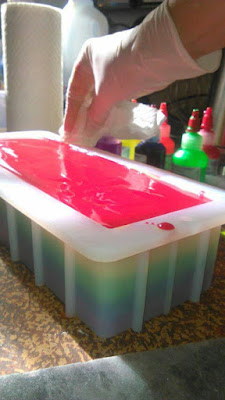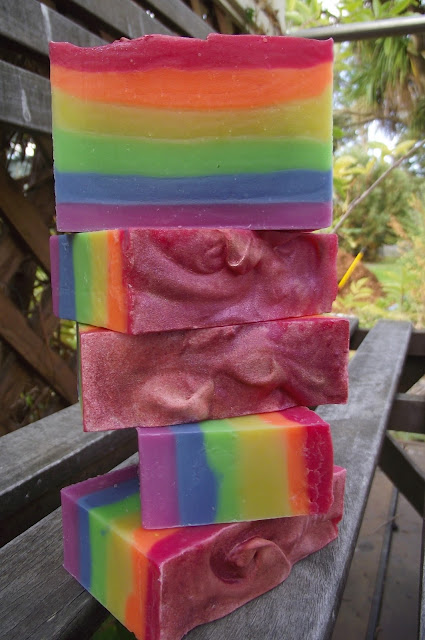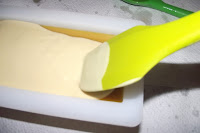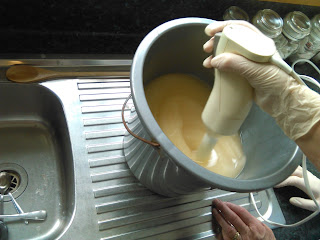Here are three soaps I recently created using Australian essential oils of Eucalyptus, Tea Tree and Lemon Myrtle. The aim was to create soaps with fragrances reminiscent of leisurely hikes through the Aussie bush.
This one is a mix of all three of our favourite bushy essential oils (above) which I've named "Aussie Bush Soap". I used Australian Pink Clay as one of the colourants and went with an in-the-pot swirl (swirling different coloured soap batters together in the soap pot then pouring into a mould.)
This "Aussie Gumtree Soap", as you would expect, is eucalyptus scented. I also included a small amount of peppermint oil to soften the eucalyptus scent just a tad. I created a natural swirly look by dividing the batter into halves, colouring with yellow and green clay, and doing an in-the-pot swirl before pouring into the mould.
My husband really wanted a tea tree scented soap but, after much experimenting with it, I came to the conclusion that the saponification process (the chemical reaction which turns oils into soap) is not kind to the smell of tea tree on its own. To rectify this I made a handmilled soap which involves making a plain soap first then grating it up, melting it down and adding the essential oils last. This ensures the essential oil retains all of its properties and scent in the soap. I was very happy with the outcome. Like the "Aussie Gumtree Soap", I also added some peppermint oil to soften the scent of the tea tree and found that the two blend beautifully.
RECIPES:
Aussie Bush Soap
40% Olive oil
25% Coconut oil
15% Palm oil
10% Cocoa Butter
5% Avocado oil
5% Castor oil
1% Eucalyptus Blue essential oil
1% Tea Tree essential oil
0.5% Lemon Myrtle essential oil
Run recipe through a
lye calculator to find water and sodium hydroxide amounts.
Divide batter equally into 3 jugs, colour one with Aussie pink clay and the other with dark green liquid dispersion. Leave the third one plain.
Do an in-the-pot swirl and pour into a silicone
10 inch mould which can also be found
here.
Aussie Gumtree Soap
40% Olive oil
25% Coconut oil
25% Palm oil
10% Cocoa Butter
2.5% Eucalyptus essential oil
1% Peppermint oil
Run recipe through a
lye calculator to find water and sodium hydroxide amounts.
Handmilled Tea Tree & Peppermint
Make a plain soap using the following ingredients and pour into a silicone
10 inch mould.
44% Olive oil
33% Coconut oil
23% Palm oil
(Run recipe through a
lye calculator to find water and sodium hydroxide amounts.)
After 1-2 days, grate soap and melt down in a crock pot with a little bit of de-mineralised water (approximately 50 grams or so). Stir occasionally.
When soap has melted and there are no large lumps in the batter and soap can be easily mixed with a wooden spoon, blend soap with an electric stick blender until smooth.
Add essential oils (or fragrance oils) and blend until fully incorporated. I used the following:
- 1.5% Tea Tree essential oil
- 1.5% Peppermint essential oil
Working as quickly as possible pour (plop!) mixture into a silicone
10 inch mould.
Cover with plastic wrap and press down with hands to get batter right down into the mould. Give it a good thump on the work bench also.
Leave to harden overnight, then slice up and cure as usual. (I leave these ones for a minimum of 10 weeks to ensure maximum evaporation of water and a harder soap.)
























































